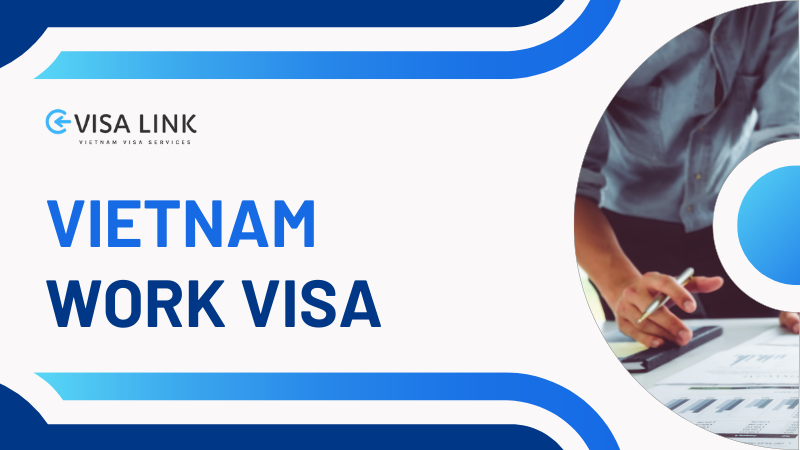Vietnam Work Visa 2023: Application Guide for Foreigners
Vietnam work visa procedures might be on your mind. Have you ever pondered the intricacies of securing one? Dive into our comprehensive guide to learn everything you need to know. From the various visa types, requirements, and essential documents, to the detailed application process and processing times, we’ve got you covered. Let us assist you in understanding and navigating the visa acquisition journey in the stunning land of Vietnam. Don’t let the visa process hold you back; embark on your exciting Vietnamese adventure today!
Introduction to Vietnam Work Visa
For foreigners aspiring to work legally in Vietnam, obtaining a Vietnam work visa, which falls under the categories LD1 and LD2, is of paramount importance. This document is essential for securing employment opportunities within the country. In this comprehensive guide, we will delve into the significance of the Vietnam work visa for foreign individuals looking to establish their careers in Vietnam.
Understanding Vietnam Work Visas
- LD1 Visa: The LD1 visa is issued to foreigners who are exempt from obtaining a work permit to work in Vietnam. Such exemptions are typically granted under specific circumstances or in accordance with international treaties to which Vietnam is a signatory. Holders of LD1 visas enjoy the privilege of working in Vietnam without the burden of obtaining a work permit.
- LD2 Visa: In contrast, the LD2 visa is designed for foreigners who are mandated to secure a work permit to legally work in Vietnam. Individuals holding LD2 visas must ensure they possess a valid work permit before commencing their employment in Vietnam.
Key points to remember
- The Vietnam Work Visa usually carries a validity period of up to 2 years.
- Extensions for the work visa can be obtained, providing flexibility for foreign workers.
- If the corresponding work permit is valid for less than one year, the duration of the LD1 or LD2 visa will be aligned with that of the work permit.
Significance of Vietnam Work Visa
The visa to work in Vietnam is a vital document for foreign nationals wishing to join the Vietnamese workforce. It serves as a key instrument in ensuring compliance with the country’s labor regulations and international agreements. Familiarizing yourself with the precise requirements and procedures associated with LD1 and LD2 visas is of utmost importance for foreign employees and employers alike, guaranteeing a seamless and legally compliant entry into Vietnam’s employment sector.
Uncovering the legal framework of Vietnam Work Visas
If you’re a foreigner interested in working in Vietnam and are seeking a comprehensive guide on obtaining a work visa, you’ve come to the right place. In this detailed analysis, we will delve into the complexities of Vietnamese laws and regulations that govern the issuance and usage of work visas, offering valuable insights into the country’s immigration and employment regulations for foreigners looking to work in Vietnam.
Exploring Vietnamese legal framework
- Law No. 47/2014/QH13: This cornerstone legislation addresses the entry, exit, transit, and residence of foreigners in Vietnam. It sets the stage for the legal presence of foreign nationals in the country.
- Law No. 51/2019/QH14: Serving as an amendment and supplement to Law No. 47/2014/QH13, this law introduces revisions and updates to the legal framework governing the activities of foreigners in Vietnam.
- Circular No. 04/2015/TT-BCA: Delving into the specifics, Circular No. 04/2015/TT-BCA lays out regulations concerning the requisite specimen documents for foreigners entering, exiting, and residing in Vietnam. It ensures meticulous documentation and record-keeping for foreign individuals.
- Decree No. 11/2016/ND-CP: This decree intricately manages the implementation of the Labor Code pertaining to the issuance of work permits to foreign workers in Vietnam. It also outlines the process for the expulsion of foreign workers who do not possess the essential work permits.
The changing landscape of Vietnam Work Visa regulations
Vietnam’s work visa regulations have undergone notable transformations, reflecting the nation’s evolving economic, social, and political landscape. These changes encompass several key aspects:
- Economic Growth: The rapid economic growth in Vietnam has led to an increased demand for foreign labor in various industries. Consequently, adjustments to work visa regulations have aimed to facilitate the entry of skilled foreign workers, boosting economic development.
- International Agreements: Vietnam’s participation in international treaties and agreements has influenced its visa policies. Commitments made in these agreements may necessitate changes to align with international standards and cooperation.
- Streamlined Processes: Amendments to visa regulations have aimed to streamline application processes, making it more accessible for foreigners to obtain work visas. This encourages foreign investment and talent recruitment.
- Enhanced Compliance: Changes have been implemented to ensure that foreign workers comply with Vietnamese labor laws and regulations, with a focus on work permit requirements.
- Global Trends: Global trends, such as the increasing mobility of the workforce and the digitalization of immigration processes, have prompted updates to visa regulations to keep pace with evolving global norms.
A step-by-Step guide to acquiring a Vietnam Work Visa
Step 1: Preparation of documents by the Vietnam-based company
The company in Vietnam where the foreigner will be employed acts as a guarantor and must prepare the following documents to apply for a work permit for the foreign employee:
- Operation license of the company (e.g., Business registration certificate, investment license, or branch/representative office operation license)
- Certificate of seal specimen or Statement of Seal Use by the Company
- Form NA16 – Registration form for the seal and signature of the legal representative of the enterprise operating in Vietnam
- Form NA5 – Application for visa, visa extension, extension of stay for foreigners in Vietnam
- 01 3x4cm photo
- Work permit or work permit exemption certificate
- Copy of the foreigner’s valid passport
Step 2: Document submission
A representative from the entity where the foreigner will work submits the prepared documents to the Vietnam Immigration Department or the Immigration Office under the Department of Public Security in the city or province where the company’s head office is located.
After submission and payment of the visa fee, the submitter will receive an appointment note specifying the expected date to receive the visa processing result.
For visa stamping at the Vietnam embassy/consulate in a foreign country, a Fax charge must be paid.
Submission is typically done from Monday to Friday and Saturday mornings.
Step 3: Receive the Work Visa letter for Vietnam
On the appointed date, the company’s representative visits the Immigration department/office to collect the visa letter (if issued).
Step 4: Inform the foreign worker
After obtaining the letter, the company must notify the foreign employee through email, fax, or express courier, allowing the foreigner to complete the visa procedure.
Step 5: Receive the Visa and pay fees
The foreign worker, in their host country, visits the office of the Vietnam embassy/consulate.
The foreigner submits the following:
- Form NA1 – Vietnamese Visa Application with a 3x4cm photo attached
- Original valid passport
- Copy of the visa letter issued by the Immigration Department/Office of Vietnam
- Payment of the visa fee imposed by the embassy/consulate to have the work visa stamped onto their passport.
Contrasting Vietnam Work Visa with Vietnam Business Visa
Purpose of Visa:
- A Vietnam Work Visa (LD visa) is specifically issued to foreigners who are coming to work for a Vietnam-based company or office.
- A Vietnam Business Visa (DN visa) is granted to individuals who are coming to work with Vietnam-based enterprises but are not directly employed by a Vietnamese company.
Application process:
- Business visas (DN visa) can be applied for online or directly at the Vietnam embassy/consulate in a foreign country by the foreigners themselves.
- Work visas (LD visa) are applied for in Vietnam by the company where the foreigner will work, and the visa is then stamped at the embassy/consulate in the foreign country by the foreigner themselves.
Work permit requirement:
- A work visa (LD visa) typically requires a valid work permit for the foreigner to be eligible.
- A business visa (DN visa) does not require a work permit.
Validity duration:
- Work visas (LD visa) may have longer validity periods compared to business visas.
Temporary residence card:
- With a work visa (LD visa), it is possible to apply for a temporary residence card in Vietnam.
- A business visa (DN visa) does not allow for the application of a temporary residence card.
Common issues and practical solutions
Applying for a Vietnam Work Visa can be challenging due to common hurdles like documentation errors and process misunderstandings. To help you succeed, we’ll discuss these issues and offer practical tips:
- Documentation Errors: One of the most common stumbling blocks in the visa application process is documentation errors. Small mistakes in your paperwork can lead to delays or even denials. To avoid this, meticulously review all required documents, such as your work permit, business licenses, and visa application forms. Seek assistance from experts if necessary to ensure accuracy.
- Incomplete Paperwork: Incomplete paperwork can also hinder your application. Ensure that you have gathered all necessary documents and that they are up-to-date. This includes having a valid passport, a work permit, and any additional documents required by the Vietnamese authorities.
- Misunderstanding the Process: Misunderstanding the visa application process is another prevalent challenge. It’s essential to comprehend the different visa categories (e.g., LD1, LD2) and the specific requirements for each. Many applicants confuse business visas with work visas, leading to complications. Educate yourself about the visa category that suits your purpose of stay to avoid confusion.
- Work Permit Requirement: For those applying for work visas (LD visa), obtaining a work permit is mandatory. Failure to secure a work permit can result in visa denials. Make sure you meet the qualifications and have a valid work permit in place before applying for a work visa.
- Delays in Processing: Processing times for visas can vary, and delays may occur. Plan your visa application well in advance to allow for processing time and unforeseen delays. It’s advisable not to book travel or commit to work engagements until your visa is in hand.
- Language Barriers: Navigating the application process in a foreign language can be challenging. Seek assistance from a reputable immigration consultant or language translator to ensure that you correctly fill out forms and provide necessary information
Conclusion
Navigating the complexities of the Vietnam work visa process is pivotal for those desiring to delve into the country’s rich professional environment. As Vietnam emerges as a thriving hub for global talent, understanding its visa guidelines becomes even more crucial. With this guide, we hope to have simplified the intricate facets of obtaining a work visa for Vietnam. Whether you’re a seasoned professional or a budding talent eyeing opportunities in this Southeast Asian gem, always prioritize staying informed and compliant. As the world becomes more interconnected, let the Vietnam work visa be your key to unlocking boundless professional vistas in this vibrant nation. Safe travels and fruitful endeavors await!


